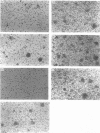Abstract
The data presented in this report demonstrate that antibodies directed against B-cell specific surface antigens can block different modes of B-cell activation. The anti-CD 19 antibody HD37 strongly blocks the stimulation of thymidine incorporation induced by anti-mu and MLR supernatant and also partially inhibits the growth of long-term EBV-transformed cell lines. The anti-CD20 antibody B1, on the other hand, has little effect on anti-mu activation but prevents the stimulation of thymidine incorporation and transformation by EBV. We conclude that different mechanisms operate during B-cell activation by anti-mu and EBV involving different B-cell surface molecules.
Full text
PDF





Images in this article
Selected References
These references are in PubMed. This may not be the complete list of references from this article.
- Clark E. A., Shu G., Ledbetter J. A. Role of the Bp35 cell surface polypeptide in human B-cell activation. Proc Natl Acad Sci U S A. 1985 Mar;82(6):1766–1770. doi: 10.1073/pnas.82.6.1766. [DOI] [PMC free article] [PubMed] [Google Scholar]
- Dongworth D. W., Klaus G. G. Effects of cyclosporin A on the immune system of the mouse. I. Evidence for a direct selective effect of cyclosporin A on B cells responding to anti-immunoglobulin antibodies. Eur J Immunol. 1982 Dec;12(12):1018–1022. doi: 10.1002/eji.1830121207. [DOI] [PubMed] [Google Scholar]
- Fauci A. S., Pratt K. R., Whalen G. Activation of human B lymphocytes. II. Cellular interactions in the PFC response of human tonsillar and peripheral blood B lymphocytes to polyclonal activation by pokeweed mitogen. J Immunol. 1976 Dec;117(6):2100–2104. [PubMed] [Google Scholar]
- Golay J. T., Clark E. A., Beverley P. C. The CD20 (Bp35) antigen is involved in activation of B cells from the G0 to the G1 phase of the cell cycle. J Immunol. 1985 Dec;135(6):3795–3801. [PubMed] [Google Scholar]
- Kehrl J. H., Muraguchi A., Fauci A. S. Differential expression of cell activation markers after stimulation of resting human B lymphocytes. J Immunol. 1984 Jun;132(6):2857–2861. [PubMed] [Google Scholar]
- Martínez-Maza O., Britton S. Frequencies of the separate human B cell subsets activatable to Ig secretion by Epstein-Barr virus and pokeweed mitogen. J Exp Med. 1983 Jun 1;157(6):1808–1814. doi: 10.1084/jem.157.6.1808. [DOI] [PMC free article] [PubMed] [Google Scholar]
- Muraguchi A., Butler J. L., Kehrl J. H., Falkoff R. J., Fauci A. S. Selective suppression of an early step in human B cell activation by cyclosporin A. J Exp Med. 1983 Sep 1;158(3):690–702. doi: 10.1084/jem.158.3.690. [DOI] [PMC free article] [PubMed] [Google Scholar]
- Muraguchi A., Fauci A. S. Proliferative responses of normal human B lymphocytes. Development of an assay system for human B cell growth factor (BCGF). J Immunol. 1982 Sep;129(3):1104–1108. [PubMed] [Google Scholar]
- Reedman B. M., Klein G. Cellular localization of an Epstein-Barr virus (EBV)-associated complement-fixing antigen in producer and non-producer lymphoblastoid cell lines. Int J Cancer. 1973 May;11(3):499–520. doi: 10.1002/ijc.2910110302. [DOI] [PubMed] [Google Scholar]
- Tosato G., Blaese R. M., Yarchoan R. Relationship between immunoglobulin production and immortalization by Epstein Barr virus. J Immunol. 1985 Aug;135(2):959–964. [PubMed] [Google Scholar]



